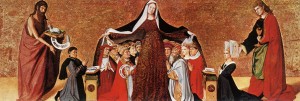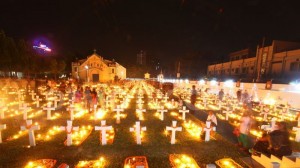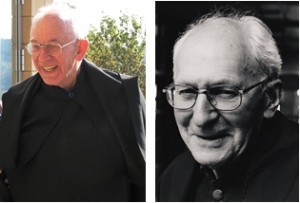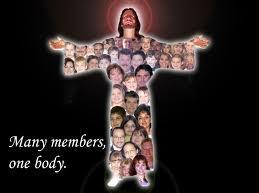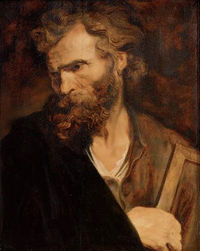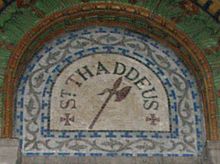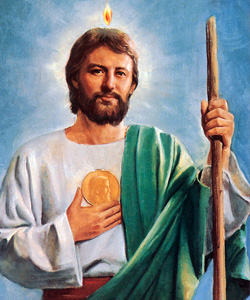We are just about to end the Church’s liturgical year, as next Sunday is the first Sunday of Advent. Once again the life, death, resurrection and ascension of Jesus will be presented for us amid the events that 2012-2013 will bring to us. But also there will be the feast of Pentecost, the long series of feasts of Our Lord: Corpus Christi, The Sacred Heart, Christ the King, and of Our Lady, the Saints and feasts of the Church, not just as historical memories, but as different lights for our lives in the one light of Jesus, the Word made flesh. Now we are urged by the Church to look forward to the second coming of Jesus, both these past two weeks of the old year and in the first two weeks of Advent. It is in this context that Socius offers this reflection to our readers, and it deals with our continual response as the Body of Christ on earth to the Holiness of God.
Father Jonathan
Nostalgia! One definition of this word would have us understand that it is nothing more than a sentimental longing for the past – of recollections through ‘rose coloured glasses’ – and something we often do, but which should be avoided, for there is ‘no future in living in the past’. However, it is something we all do from time to time; moreover, it is not just the preserve of those of middle age and older. I have often heard youngsters coming out with the prelims, “I remember when….”, or “Do you remember when….” In my own case, I cannot help but recollect the times when ‘such and such’ was the case, and these words are most often then followed by observations as to how things have changed over the years since that original state of affairs. I think we are all students in time – all still learning – learning from lessons in the past; the past is still one of our best teachers, providing we are prepared to learn from it. One old maxim I learned many years ago runs along the lines: “learn from yesterday, live for today and plan for tomorrow”.
For years before Vatican II, when attending Mass in Latin was the norm, an alter server would be required to sound the altar bell no less than thirteen times, three times at the ‘Sanctus’, once as the priest pronounced the words of blessing on the bread and wine, to be offered in sacrifice, six times at the Consecration and three times, again, at the ‘Domine non sum dignus’ (Lord, I am not worthy). Today, we do not demand nearly so much muscular activity from those assisting at Mass, and the ‘Sanctus’, (Holy, Holy, Holy), at the conclusion of the ‘Preface’, which marks the start of the Canon of the Mass, is not accompanied by the ‘peal’ of three bells, as it once was.
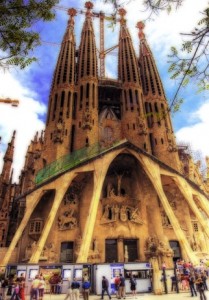 |
The towers of the huge Sagrada Familia church in Barcelona are decorated with the words: “Sanctus”, “Hosanna” and “Excelsis”
It is to the ’Sanctus’ (Holy, Holy, Holy,) of the Mass that I now turn my attention. As I said just a moment or two ago, the Latin ‘Sanctus’, translated as ‘Holy’ in English, comes at the end of the Preface and this takes us then into the most important part of the Mass:
Sanctus, Sanctus, Sanctus
Dominus Deus Sabaoth.
Pleni sunt caeli et terra gloria tua.
Hosanna in excelsis.
Benedictus qui venit in nomine Domini.
Hosanna in excelsis.
Holy, Holy, Holy
Lord God of hosts.
Heaven and earth are full of your glory.
Hosanna in the highest.
Blessed is he who comes in the name of the Lord.
Hosanna in the highest.
In the ‘old days’, the bell would be rung as the priest intoned the words, “Sanctus, Sanctus, Sanctus…”, and he would bow his head in adoration as he said them. He would then continue, in lower voice, until he reached the second part of the ‘Hymn’ – the ‘Benedictus’ – at which point he would stand erect again, and make the Sign of the Cross, as he said the words: “Benedictus qui venit in nomine Domini…” (“Blessed is he who comes in the name of the Lord….” Today, the congregation joins with the priest, and they say the words of the ‘Holy, Holy, Holy Lord’ together; the priest stands erect throughout, no ‘Sign of the Cross’ is made, and the bell does not sound.
But, what is this all about? What is its history and why is it so important? The ‘Sanctus’, or ‘Holy, Holy, Holy’, is nothing less than a great hymn of praise to God. The first part finds its origin in the Old Testament and Isaiah’s vision of heaven, in which God sits on his throne, surrounded by angels. In Isaiah 6:3, it is said that: “And one called to another and said: “Holy, holy, holy is the Lord of hosts; the whole earth is full of his glory!” In the Jewish liturgy, the congregation prays this verse from Isaiah, as the cantor sings the 18 benedictions before opening the Ark of the Covenant. It can be compared to the ‘Trisagion’ (Greek), or in Latin, the ‘Tersanctus’, often called by its opening line, the ‘Agios O Theos’, “Holy God, Holy Mighty, Holy Immortal, have mercy on us.” In western Christianity, the ‘Agios O Theos’ is most often sung during the Good Friday Liturgy of the Passion. As to the second part of the ‘Holy, Holy, Holy’, this comes from Matthew 21:9, in which the evangelist describes Jesus’s entry into Jerusalem, found in today’s Mass for Palm Sunday:
“… the multitudes … cried, saying,
Hosanna to the Son of David:
Blessed is he that cometh in the name of the Lord:
Hosanna in the highest.”
The word ‘Hosanna’ is a Jewish word; its original meaning was ‘Save’, but, with the passage of time, the meaning has changed and it now is very much used as a word of ‘Praise’ to God. As to the word, ‘Sabaoth’, used in the Latin text, I was always puzzled by the meaning of the word and its translation as ‘Hosts’. Actually, the word is a very old Jewish word, correctly translated as ‘host’ or ‘army’, and most often, now in the plural, taken to mean hosts of angels, since it is today used almost exclusively as a title for God, viz. ‘The Lord God of Hosts’.
Icon of Christ, the Ancient of Days, fresco Ubisi, Georgia
The ‘Trisagion’ and the ‘Tersanctus’, it would seem, are not one and the same hymn of praise to God, and so much be distinguished from one another, though many authorities would argue that, inevitably, there must be some kind of association between the two. The former precedes the latter by eons, as the origins of the ‘Trisagion’ are of great antiquity. The words, “Holy God, Holy Mighty, Holy Immortal, have mercy on us,” according to tradition, came into being as a violent earthquake hit Constantinople during the first half of the 5th century, and the people were terrified for their lives. They prayed to God for deliverance, and as they did so, a child was lifted up above their heads. The cry then, by one and all, was ‘Kyrie eleison’ (Lord, have mercy.) The child was brought back down to earth and he then shouted for the people to pray: “Holy God, Holy Mighty, Holy Immortal”. All became calm and the child went to sleep, none the worse for his experience. There are other theories that take its origin back even before this event – even to Apostolic times.
But, to return to the ‘Sanctus’ and, as was said earlier, its place as a great hymn of praise to God. In most ‘low’ Masses, it is said (or sung) by the priest, the congregation joining in according to their capabilities. However, as one of the most important parts of the Liturgy, it has been taken by great composers the world over, and set to the most wonderful music – usually involving soloists, choirs and organ accompaniment. On solemn occasions, for example as part of a Requiem Mass, it may be sung in plain chant – and many such arrangements have been composed for this purpose. In all, wherever and whenever it is sung, there is no doubt that it often has that ability, to drive home the thought, that this is the high point of the Mass. I can call to mind the great Sanctuses of Bach, Mozart, Beethoven, Brahms, Bruckner, Duruflé, Fauré, Puccini, and Verdi – the list goes on and on. All of them, each in their own individual fashion, bring the most wonderful sense of praise and thanksgiving, to this great hymn of praise to God. That’s the music – but the words are right at the root; they harness our thoughts, our feelings, all our innermost and most secret outpourings of our hearts, and offer them up to God, Our Heavenly Father. And that’s what prayer is all about!
Truly, and without question, the ‘Holy, Holy, Holy’, is one very great and wonderful prayer to Him.
To view the blog in its orignal format, please go to the main blog site.
Socius
